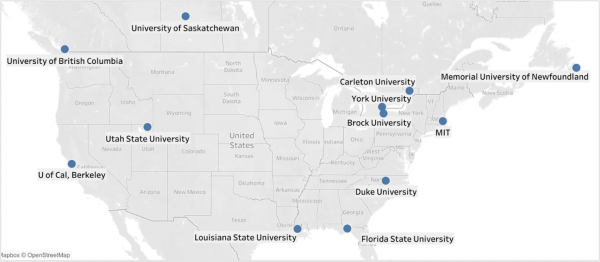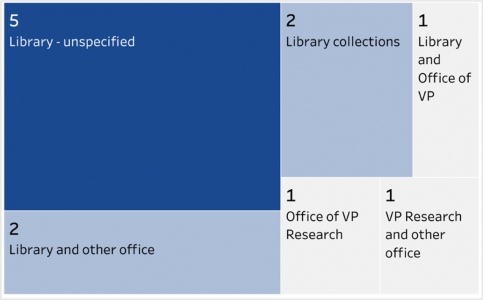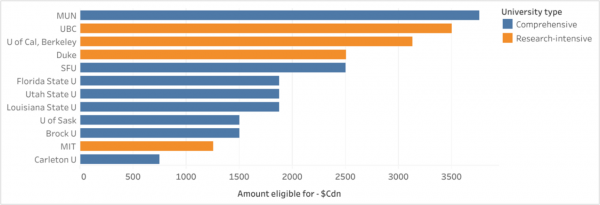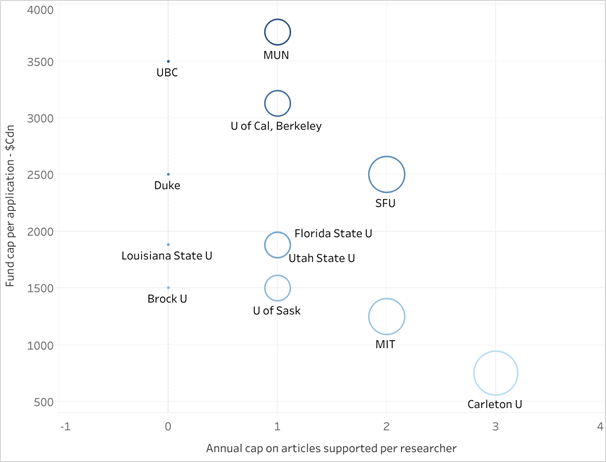Introduction
As part of an evaluation of the SFU Central Open Access Fund, this project was an environmental scan and summary of open access funds or similar projects at comparable institutions in Canada and the US. The Digital Scholarship Librarian used the scan to help interrogate the criteria and administration of SFU's OA Fund and provide recommendations to the Associate Dean, Collections & Scholarly Communications.
This project appealed to me because it was connected to scholarly communications generally and specifically to work done at SFU library, which contributes to incentivizing scholarly researchers to publish OA and to reducing barriers to open-access publishing. I have an interest in how librarians can contribute to expanding the impact of scholarly research, of which making research outputs openly accessible to those outside academia—policymakers, community organizers, the generally public— is one important part.
Context within Academic Librarianship
It is not always apparent why researchers need to be incentivized to publish open access. There are measurable benefits of publishing OA, including the impact of scholarly research – studies have shown that the impact of scholarly research published in Open Access journals in contrast to toll journals, is greater and have found this is true across many disciplines (Norris, Oppenheim & Rowland 2008,
Ottaviani 2014). In Canada, publishing Open access can help researchers fulfill the mandates of the Tri-Agencies around research outputs being freely accessible within a certain period. So why do libraries need to support researchers and do advocacy work promoting OA?
There are plenty of barriers to scholarly researchers publishing the OA route. These range from the entrenched Promotion and Tenure system, which pressures scholars to publish in established and prestigious journals, scholars’ anxiety over IR archiving requirements, confusion, stress, and time required for paying OA publishing fees, and these fees themselves.
In the scholarly communications and publishing landscape, ultimately, someone has to pay for open access—publishing quality-controlled scholarship, disseminating and marketing it, administering rights and permissions, and so on, is not free. So, for commercial OA publications, sometimes they put these costs back on the author, usually through author processing charges (or APCs). These can be paid by authors themselves, their institutions, or by memberships. These fees can range from a couple of hundred dollars to a couple of thousand dollars depending on the journal. The open-access funds I examined during this project aim to reduce open-access publishing barriers, particularly regarding paying these APCs and navigating fee payment. These programs aim to support scholarly authors who wish to make their work open access to do so.
Institutions scanned

Selected Findings
Management
OA funds budgets:
- vary significantly, range from $15,000 Cdn (Brock University) to $100,000 Cdn (Memorial University of Newfoundland)
- mean of $53,000 Cdn for the Canadian schools
- few institutions disclose up-to-date figures
- difficult to determine whether large, more research-intensive institutions draw on the deepest OA fund budgets
Fund management body

Caps on applications
- nearly all universities scanned cap the amount a researcher can receive per application
- max a researcher can receive ranges from $750 (Carleton University) to $3750 Cdn (MUN)
- overall, large research-intensive universities have a higher cap than comprehensive
- for comprehensive schools, medium cap is $1880 Cdn

Fund usage
- data on annual usage rates was not found for most funds covered in this scan
- Scholarly Publishing and Academic Resources Coalition provides some data on OA fund usage for North American universities, primarily the total sum since each fund began
- due to the lack of data on whether funds have been continuously active over this period as well as issues with currency, SPARC’s fund usage data was not included in the scan
Criteria for funds
Who is eligible

Format of scholarly output
- half the OA funds cover only articles published in OA journals
- other half extend this to include OA monographs and book chapters
- one university, the University of Saskatchewan, extends coverage to creative works
IR deposit
- deposit of funded materials in an institutional repository required at seven institutions
- all but one of the comprehensive schools (University of Saskatchewan) mandate archiving in the IR
Cap per application & number of funds permitted annually per researcher

Click and Borchardt (2019, p. 32) have observed that OA fund administrators adopt various cost-saving measures, including implementing maximum article and author fees. This scan found such cost-saving strategies, with most institutions strictly limiting the number of applications per researcher per year. Most universities limit researchers to receiving funds between three times to once a year. With lower fund amounts permitted per application, MIT and Carleton University unsurprisingly offer more opportunities for a researcher to receive funds annually than other universities with annual limits. Although not explicitly limiting the times a researcher can receive funds annually, UBC limits a researcher to just $3500 per year—simply another cost-saving measure. Another cost-saving strategy of note is how the Utah State University Libraries require their fund allocations (capped at $1500 US per application) to be matched by an applicants’ department, college, or an outside granting agency for full funding to be guaranteed.
OA journal eligibility
- nearly all funds require journals be GOLD open access, peer-reviewed, listed in the DOAJ, and adhere to the best practices set by the OASP Association and/or the Committee on Publication Ethics
- criteria for OA monographs and book chapters are less well-defined and transparent
Future Directions
SFU stakeholders should be aware that alternative OA publishing support models are emerging. Click and Borchardt (2019) outline how some universities (e.g. University of Arizona) have transitioned away from the OA publishing fund model in recent years. Instead, they “now pay for institutional memberships with specific publishers that include APC discounts, as well as initiatives with “wide potential global impact”” for example, discipline-specific open repositories (p. 32-33). In this way, four universities initially included in this scan now support researchers by means of APC discounts with publishers through licensing agreements and funds for membership fees to OA repositories (the University of Victoria, University of Calgary, Concordia, and UNC-Chapel Hill). With OA’s prevalence increasing, understanding and assessing how the variety of funding models sustain open access publishing across all disciplines and research output formats will become more critical Cantrell & Swanson, 2020, p. 5.
References
Beaubien, S., Garrison, J., & Way, D. (2016). Evaluating an Open Access Publishing Fund at a Comprehensive University. Journal of Librarianship and Scholarly Communication, 3(3). https://doi.org/10.7710/2162-3309.1204
Cantrell, M. H., & Swanson, J. A. (2020). Funding Sources for Open Access Article Processing Charges in the Social Sciences, Arts, and Humanities in the United States. Publications, 8(1), 12. https://doi.org/10.3390/publications8010012
Click, A. B., & Borchardt, R. (2019). Library Supported Open Access Funds: Criteria, Impact, and Viability. Evidence Based Library and Information Practice, 14(4), 21–37. https://doi.org/10.18438/eblip29623
Concordia University Library. (2019). Concordia University Open Access Author Fund Annual Report, FY 2018-19 (p. 5) [Annual Report]. Concordia University Library. https://library.concordia.ca/research/open-access/OA-Author-Fund-Report-2018-19.pdf
Concordia University Library. (2020). OA Author Fund tracking [Data set]. https://library.concordia.ca/research/open-access/OA-Author-Fund-Request-Tracking.xlsx
Dalton, E. D., Tenopir, C., & Björk, B.-C. (2020). Attitudes of North American Academics toward Open Access Scholarly Journals. Portal: Libraries and the Academy, 20(1), 73–100. https://doi.org/10.1353/pla.2020.0005
Norris, M., Oppenheim, C., & Rowland, F. (2008). The citation advantage of open-access articles. Journal of the American Society for Information Science and Technology, 59(12), 1963–1972.
Ottaviani, J. (2016). The Post-Embargo Open Access Citation Advantage: It Exists (Probably), It’s Modest (Usually), and the Rich Get Richer (of Course). PLOS ONE, 11(8).
Scholarly Publishing and Academic Resources Coalition. (2021). OA Funds in Action [Data set]. https://docs.google.com/spreadsheets/d/10Ask0ac-N91B4EMLVOhWOxL5CKv1h47aGmLysACn_8Q/
Tenopir, C., Dalton, E., Christian, L., Jones, M., Mccabe, M., Smith, M., & Fish, A. (2017). Imagining a Gold Open Access Future: Attitudes, Behaviors, and Funding Scenarios among Authors of Academic Scholarship. College and Research Libraries, 78(6). https://doi.org/10.5860/crl.78.6.824
Yates, E., Hampson, C., Hatherill, J., Lavigne, J., Nariani, R., Paterson, J., Shires, M., & Tiessen, R. (2016). Library Open Access Funds in Canada: Review and recommendations (p. 43). Canadian Association of Research Libraries CARL. http://www.carl-abrc.ca/doc/CARLOAWGLibraryOAFundsFinalReport-Jan%202016.pdf

Related Activity: Scan-on-demand services


During the research for this scan and while preparing for a short presentation for SFU Library staff and librarians, I was able to review course materials, discussions, and reading materials from the course LIBR 559L Issues in Scholarly Communications and Publications.